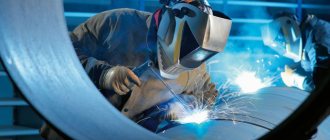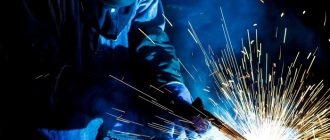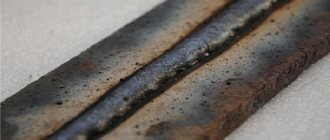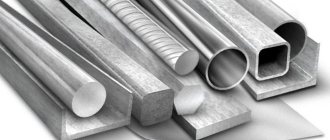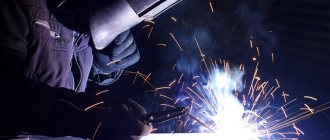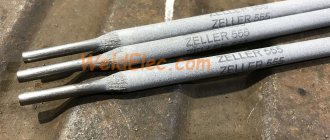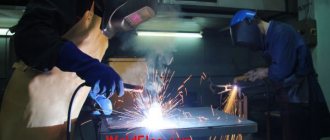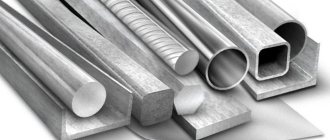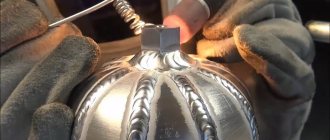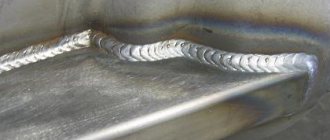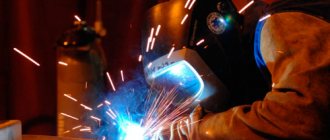Low carbon steel and its properties
Low carbon steel belongs to a large group of structural steels. The carbon content in it is no more than 0.3%; due to such a low percentage, it has the following properties:
- High plasticity and elasticity;
- Well suited to the welding process;
- High impact strength.
This brand is widely used in construction due to the fact that it is very easy to weld, since there is very little carbon in its structure, which has a bad effect on the welding process, since brittle structures and porosities can form in the metal seam, which then lead to failure. Also, due to its high softness, parts are made from it using cold stamping.
Austenitic
Austenitic steels are materials that contain the high-temperature phase of iron - austenite. They are included, for example, in the group of chromium-nickel steels, which can work in various aggressive environments and at very high temperatures.
The main feature when welding corrosion-resistant steel is the need to ensure resistance to intercrystalline corrosion in the heat-affected zone.
The problem is that even with preheating of the steel, chromium carbides fall out of the crystal lattice along the heating boundaries. As a result of a decrease in the amount of this element in the material, upon reheating, corrosion cracking appears at the boundaries.
In practice, it may be necessary to create structures using austenitic steels with chromium-nickel alloying additives that will operate at high temperatures. To weld such structures, it is necessary to select materials in which the carbon content is as low as possible.
If it is necessary for the percentage of carbon to be higher, and at the same time, steel structures fulfill their purpose in conditions of aggressive environments and high temperatures, you need to choose an alloying additive that is similar in properties to carbon.
Titanium, zirconium, tantalum, vanadium, and tungsten can be used as such an additive. These elements bind carbon, which is released from the steel during subsequent heating, and prevent the depletion of heat-affected areas during the welding process.
Welding carbon steels
Absolutely all grades of steel can be welded. However, each type of metal has its own technology for welding. The welding technology for carbon steels must meet the requirements, which include:
- Uniform distribution of seam strength along the entire length;
- The absence of welding defects, the seams should not have various cracks, pores, grooves, and so on;
- The dimensions and geometric shape of the seam must be made in accordance with the standards prescribed in the relevant GOST 5264-80;
- Vibration stability of the welded structure;
- The use of electrodes with low hydrogen and carbon content, which can have a negative impact on the quality of the seam;
- The structure must be strong and rigid.
Thus, the technology must be as efficient as possible, that is, give the highest process performance while ensuring high strength and reliability.
The mechanical properties of the weld metal and welded joint completely depend on the microstructure, which is the chemical composition, and is also determined by the welding mode and heat treatment, which is carried out both before and after welding.
Low carbon
Low-carbon steel, which contains, in addition to carbon, alloying additives, is welded, as a rule, using any of the welding technologies.
The work does not require a highly qualified welder. Such materials are among the easily weldable steels. Therefore, conventional arc welding can be successfully used here.
Features of welding low-carbon steels are a reduced carbon content in the weld metal and an increased amount of alloying additives, so some strengthening of the weld metal in relation to the metal of the parts is possible.
Another problem that should be taken into account is the increased fragility of the seam when performing multi-layer welding.
To make connections on low-carbon steels, electrodes with rutile and calcium-fluoroisrutile coatings are used. Professional welders use electrodes coated with a little iron powder. Of the electrodes produced by industry, the following brands are suitable for welding: UONI-13/85, TsL-14, TsL-18-63.
Low carbon steels are easy to weld using acetylene. In this case, you can even do without the use of flux, and gas is consumed in a small volume.
To obtain a high-quality joint with a strength no less than that of the base metal, silicon-manganese welding wire is used. Upon completion of work with the seam, the flame is not extinguished or removed from the joint of the parts, but is smoothly deflected, allowing the seam to cool.
Low carbon steel: welding technology
As mentioned above, low-carbon steels lend themselves best to the welding process. They can be welded using gas welding in an oxy-acetylene flame without additional fluxes. Metal wires are used as an additive. Hydrogen, which can form pores, can negatively affect the welding process. To prevent this problem, it is recommended to carry out the welding process with a filler metal containing a small amount of carbon.
After the welding process, the structure must be thermally treated to improve the mechanical properties - ductility and strength will be the same. Heat treatment of welded structures is carried out by a normalization operation, which consists of heating the product to a certain temperature, approximately 400 degrees, holding and further cooling in air. As a result, the structure is equalized, carbon in the form of cementite in the metal diffuses into the grains, due to which the structure becomes uniform.
Gas welding is carried out in the presence of argon, which creates a neutral environment. Structures that are welded in an argon environment have a more important purpose.
Welding of low-carbon steels can be done manually; arc welding of such materials requires the correct choice of electrode. When choosing an electrode, it is necessary to take into account the following factors, which will ensure a uniform weld structure without defects. Before carrying out the welding process, it is necessary to calcinate the electrodes in order to prepare them for further work and remove hydrogen. Welding low-carbon iron alloys must be precise and fast, and the metal parts must be prepared before starting the process.
Stainless steel
Most often, stainless steels used in industry obtain their anti-corrosion properties through the introduction of alloying additives - chromium and nickel.
When welding chrome-plated parts, it must be taken into account that at high temperatures (more than 500 °C), oxidation of the joint of parts is possible.
To avoid this, argon arc welding, or TIG welding (TIG), is used. This technology involves the implementation of welding operations without air access directly to the welding zone. Accordingly, the absence of oxygen, the presence of which is mandatory in the air, eliminates the prerequisites for oxidation of the material.
Limiting the access of air is carried out by introducing argon, an inert gas into the welding zone, which, being heavier than air, displaces it. Sometimes this method is called steel welding with argon. In fact, steel is either simply welded together with an arc, or using filler material.
Tig welding requires special equipment. The work is carried out with non-consumable tungsten electrodes, the requirements for which are determined by GOST 10052-75.
The second problem is this. Stainless steels have a high coefficient of thermal expansion, and when welding sheet steel, when the joint is long in comparison with the linear dimensions of the part, the weld may bend during the cooling process.
The problem is solved by setting gaps between the sheets and using tacks to fix the parts in the desired position.
Requirements
When welding carbon steels, to achieve maximum parameters, the following requirements must be met:
- Welding electrodes and wires must have a low percentage of carbon to avoid unnecessary defects;
- It is necessary to ensure that carbon from the metal does not transfer into the weld under the influence of high temperature; for this, wire is used for welding steels with an average carbon content and higher, for example Forte E71T-1, Bars-71. These types are ideal for welding steels with a carbon content above 0.3%;
- When carrying out the welding process, fluxes should be added, which contribute to the formation of refractory formations;
- Reduce chemical heterogeneity of the seam by subsequent heat treatment;
- Reduce the hydrogen content by calcining the electrodes, using electrodes with low hydrogen content, etc.
Medium carbon
Due to the large amount of carbon, joining such parts is complicated. In the results of the work, this is expressed in the fact that the metal of the part and the welded joint can be of different strengths. In addition, near the edges of the seam, cracks and pockets with pronounced fragility of the material can form.
To avoid these disadvantages, electrodes are used whose material contains a low amount of carbon.
With an increase in current required to heat the parts being connected, penetration of the base metal is possible. To eliminate such cases, the edges of the parts to be joined are cut.
Another measure to improve the quality of the connection is preheating and constant heating of the parts during the process. When welding steels with a semi-automatic machine, to improve the quality of the seam, it is better to move the electrode not across, but along the joint of the parts and use a short arc. Electrodes of the brands UONI-13/55, UONI-13/65, OZS-2, K-5a are used for work.
When using acetylene for welding medium-carbon steels, a burner flame is achieved such that the gas flow rate is 75-100 dm³/h. For products with a thickness of 3 millimeters or more, general heating up to 250-300 °C or local heating up to 600-650 °C is used.
After welding, the seam is forged and subjected to heat treatment. To weld metal products with an amount of carbon close in content to high-carbon steels, a special flux is used.
Peculiarities
The following features of welding carbon steels should also be noted:
- Before carrying out this operation, it is necessary to thoroughly clean the material being welded from rust, mechanical irregularities, dirt, and scale. These contaminants contribute to the formation of cracks in the weld;
- Welding structures made of carbon steels need to be cooled slowly, in air, so that the structure normalizes;
- When carrying out the welding process, critical parts require preheating, up to approximately 400 degrees; with the help of heating, the required strength of the seam will be ensured; also in this case, welding can be carried out in several approaches.
Thus, the welding process of carbon steels depends mainly on their carbon content. Therefore, it is necessary to consider what content and choose the right technological scheme in order to obtain a high-quality, durable product that can last a long time.
High carbon
Steels with a high carbon content are very difficult to weld. Other alternative methods are used to connect parts made of such materials.
Welding of high-carbon steels that are resistant to corrosion is carried out only during repair work.
In this case, pre-heating of the seam area to 250-300 °C and subsequent heat treatment of the seam are used. It is absolutely not allowed to carry out welding work with high-carbon steels at air temperatures below 5 ° C or if there are drafts at the welding site.
If all conditions are met, welding of high-carbon steels is carried out using the same techniques as medium-carbon steels.
Gas welding with acetylene is allowed. The power of the burner flame should ensure gas consumption in the range of 75-90 dm³/h per 1 millimeter of seam thickness.
To prevent oxidation, fluxes are used whose compositions are similar to those used in welding medium-carbon steels. After gas welding, the seam is forged and then tempered.
